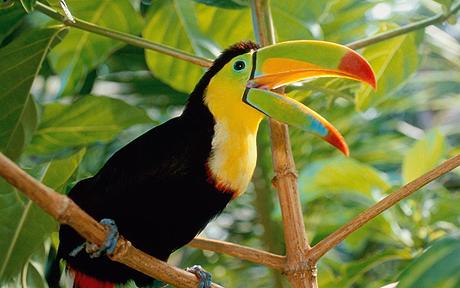 |
| Previous Image | Next Image |
| Description: The mystery of the toucan's enormous beak, which has perplexed scientists since Darwin, has been resolved after it was found to function as a natural air conditioning unit. Toucans have the biggest bill in the avian world in comparison to body size and its purpose has perplexed and fascinated naturalists in equal measure for centuries. The naturalist Charles Darwin suggested it was used as a sexual advertisement while other scientists thought it might be a specialist fruit peeler or visual warning system. However, new research has found the beak is used to keep the bird cool. Researchers in Brazil found the beak is able to cool the bird because heat is transferred into it through the blood and can then be dissipated into the air. By increasing the flow of blood to the beak, which comprises 30 to 50 per cent of the toucan's surface area, the bird succeeds in getting rid of more heat. The beak is so big that it has been found to rival an elephant's ears in helping to cool the animal down when the weather gets hot. Dr Denis Andrade, of the Universidade Estadual Paulista in Sao Paulo, studied the cooling ability of the toucan's beak by taking readings of the temperatures of six toco toucans – which have the biggest bill of all 38 species of toucans. He found the bill "routinely accounted" for 30 to 60 per cent of the South American bird's heat loss but adult birds are so adept at making the most of the beak that it can account for as much as 100 per cent or as little as five per cent. "In retrospect, it's so obvious that the beak is used to cool the bird – it's large, it has a huge surface area, it's uninsulated," he said. The findings of the study were published in the journal Science. Picture Stats: Views: 5515 Filesize: 55.74kB Height: 288 Width: 460 Source: https://biology-forums.com/index.php?action=gallery;sa=view;id=6141 |
